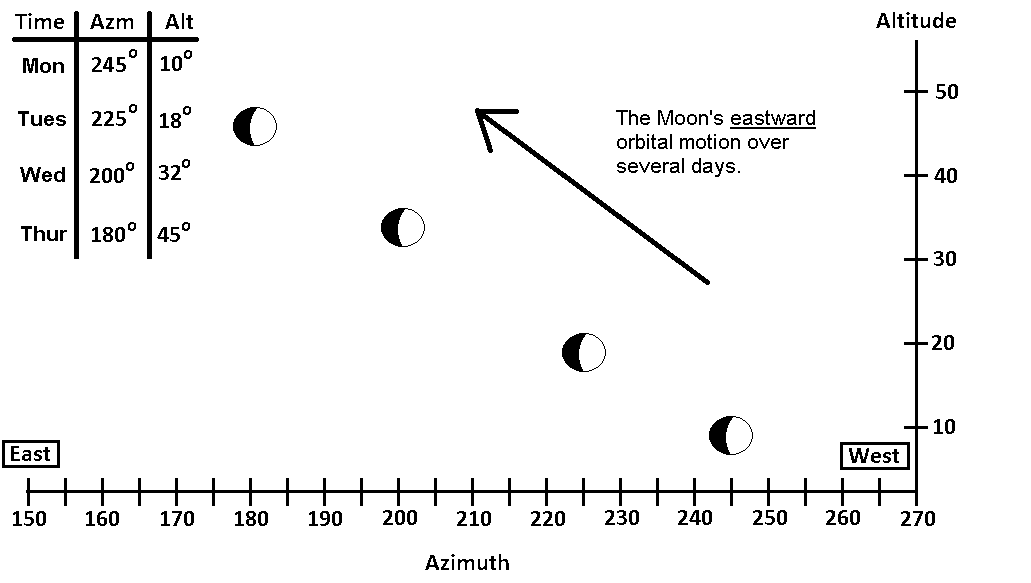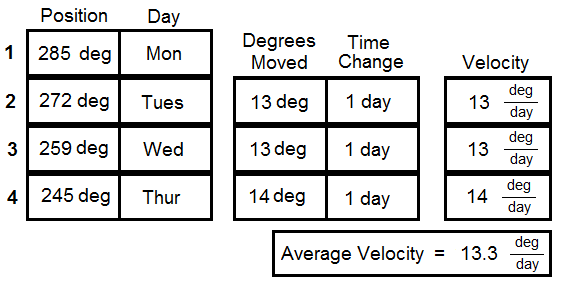5.3: Measuring the Moon’s Orbital Motion
( \newcommand{\kernel}{\mathrm{null}\,}\)
Try activity 9 again, but this time measure the Moon’s position in altitude and azimuth at the same time for several days beginning shortly after new moon, you will find that the graph is similar except that the points move eastward showing orbital motion and that the phase will change over several days! In order for this activity to be successful, students must remember to take their measurements at approximately the same time every day.
Science and Engineering Practices
- Asking questions and defining problems.
- Planning and carrying out investigations.
- Analyzing and interpreting data.
- Using mathematics.
- Argument from evidence.
Crosscutting Concepts
- Patterns in nature.
- Systems and system models.
- Stability and change.
Next Generation Science Standards
- Space systems (K-5, 6-8, 9-12).
- The Earth-Moon system (6-8, 9-12).
- Gravitation and orbits (6-8, 9-12).
For the Educator
Facts you need to know
- The Moon’s orbit around the Earth takes approximately 28 days.
- Because the Moon takes 4 weeks to orbit the Earth once – it takes about two weeks for the Moon to move from new moon (on the western horizon) to full moon (on the eastern horizon.)
- You will see that the Moon’s orbital motion moves west to east – this is in the opposite direction from its apparent east to west nightly motion.
Teaching and Pedagogy
As we have discussed in Activity #10 above, this activity is very similar. The process of measuring the Moon’s position in the sky (Altitude and Azimuth) are identical; the recording of the data will be made on an identical graph.
There are differences in the two activities, and these need to be emphasized for your students. Activity #10 is a one night event, all the data needed is gathered on one night, preferably just a few nights after the new moon. For Activity #10, students observe the Moon multiple times on the same night.
Activity #11 is different. This activity requires the student to observe the Moon of multiple successive nights – making a single observation at the same time each evening.
This sort of activity requires patience and persistence. There is no way to speed up the process, and neglecting the observations will spoil the data. Each observation takes only a few minutes, but the requirement for the observation to be taken at the same time means that parent support is needed for this activity.
Looking at it another way, this activity is an excellent way to improve parent involvement! You might wish to present this activity at a Back to School event, and get the parents involved in your school’s STEM program.
Student Outcomes
What will the student discover?
- Observations that look similar don’t always yield the same results. Sometimes paying attention to subtle details can yield ingenious discoveries.
- It is possible to track the Moon’s movement around the Earth. The Moon in orbit seems to represent the unreachable in Nature; it passes above us in the skies, but we cannot touch or influence it. Science gives us the ability to track, measure, and understand things that we cannot reach or touch.
- The Moon actually moves eastward in orbit around the Earth. Everything we observe in the skies moves westward, rising in the east and setting in the west. It is astonishing to many people to learn that the Moon travels in the opposite direction as it orbits the Earth.
What will your students learn about science?
- Science rewards the persistent. It is not easy to make observations over several nights, but the reward is the discovery of something astonishing – the Moon travels eastward – unlike most other objects in the sky.
- Planning and foresight are essential in any scientific activity. These skills pay many dividends in everyday life as well.
Conducting the Activity
Materials
- A ruler marked in centimeters
- A yardstick, tape measure, or a ruler marked in inches will work equally well – the measurements just need to be converted before plotting them on a graph.
- A compass for measuring direction.
- If the student doesn’t have a compass, the parent’s phone will suffice. Most smart phones already have a compass app on them – if not, there are many free apps of this type readily available.
Measuring the Moon’s Orbital Motion
- Begin at sunset by measuring the altitude of the Moon with a ruler – this is the Moon’s apparent distance above the horizon. Hold the ruler at arm’s length and measure the distance from the horizon to the center of the Moon’s disk. If the Moon is too high off the horizon to measure with a simple ruler, try stretching a piece of string from the horizon to the Moon’s altitude, tie a knot to mark the length and then measure the string later. If your ruler does not show centimeters, that’s okay! Just take the altitude in inches and multiply by 2.5 to get centimeters – and degrees!
- Example: The string measures as 18 inches. 18 x 2.5 = 45 cm = 45 degrees altitude!
- Measure the azimuth of the Moon with a compass. The easiest way to do this is with a compass app on a smartphone. Point the smartphone at the Moon and read the azimuth angle off the display. If you use a conventional compass, keep the needle aligned with north, then look in the direction of the Moon and find the azimuth bearing. Use the instructions that come with the compass to help you.
- Repeat the exercise for 3-5 nights in a row, measuring the altitude and azimuth position at the same time each night. Measurements should be taken as close to the same time as possible each night. Record your measurements: time, date, altitude, and azimuth neatly each time so you can graph them later.
- The next day in class, plot out your Moon position data on a graph as shown below. You can use color-dot stickers to plot the Moon’s position and color in the phase if you like!

Discussion Questions
- How does Activity #11 differ from Activity #10?
- Answer Activity #10 was a one-night activity that we used to measure the Moon’s daily motion. Activity #11 requires several nights to measure the Moon’s movement in orbit around the Earth.
- Why must we observe the Moon for several days to see its orbital motion?
- Answer The Moon takes 28 days to circle the Earth once – it moves too little in a single night to measure this change easily.
- What is causing the Moon to appear to move eastward over several days?
- Answer This is the Moon’s actual orbital motion around the Earth.
Supplemental Materials
Going Deeper
It is often valuable in science to repeat an activity a number of times to see if you get the same answer. Getting a repeatable answer is considered to be an indication that the experiment was done correctly and that the conclusions drawn from the results are reasonable.
For this activity, it turns out that once again, things are not as simple as they seem. If you run the activity the first time in the fall semester, it will be instructive to run the activity again late in the spring semester. You will find the results to be quite different!
In the fall and winter, the Moon travels high above the horizon, taking a longer path through the night skies. While in the late spring and summer, the Moon travels a lower path much closer to the southern horizon [3].
The reason for this is the tilt of the Earth’s axis. We shall examine this idea later in the book.
Being an Astronomer
Ancient astronomers paid great attention to the constellations of the zodiac. These 13 constellations lie along the path of the Moon, Sun, and planets as they move across the sky.
Many smartphones have apps available that allow you to point the phone at the sky and see a map of constellations. These applications help people identify constellations, planets, and find the names of stars in the sky.
Try using one of these applications and identify which constellation the Moon lies in as you observe it for several nights. The fact that the Moon lies in different constellations as you observe it over several days is additional confirmation that the Moon is really moving in orbit around the Earth. Add this constellation data to your graph of the Moon’s orbital motion!
Want more challenge? Leave the smartphone alone and try to identify constellations from the patterns of the stars and a star map. Excellent monthly star maps are available on line for free.
Being a Scientist
Once again, we ask the question: “How fast the Moon moving in orbit?” This time we will not be measuring degrees per minute, but rather how many degrees per day does the Moon move in orbit?
Look at the example data chart below. The student records the day and compass position of the Moon in the first two columns. To get degrees moved, start with position #2 and subtract the value above – here we subtract 272 – 285 = -13 degrees (the negative value indicates eastward motion.) Time is always 1 day because we observe the Moon at the same time each evening.
The Velocity is calculated by dividing degrees moved by time change, here the time change is always 1, so the degrees moved is the same as the velocity. Finding similar values in the last column every time gives us confidence that we have made good measurements.
 For our last step, determine how long it would take the Moon to orbit the Earth at this speed. To do this, divide 360 degrees by the average velocity. Here: 360 / 13.3 = 27 days per orbit. Any value between 25 and 30 days per orbit is a reasonably good match to the true value of 28.3 days.
For our last step, determine how long it would take the Moon to orbit the Earth at this speed. To do this, divide 360 degrees by the average velocity. Here: 360 / 13.3 = 27 days per orbit. Any value between 25 and 30 days per orbit is a reasonably good match to the true value of 28.3 days.
Following Up
The two moons of Mars, Phobos and Deimos, are an interesting comparison to Earth’s moon. These two moons move around Mars at very different speeds from each other – and much faster than Earth’s moon.
What can you find out about the orbital period of Phobos and Deimos? Why are they so different from each other? What controls the speed of a satellite in orbit?


